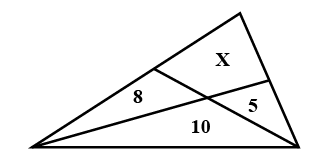
A triangle is divided into 4 parts and the area of the 4 regions are given inside the corresponding regions. Find the value of x if the area of the triangle is 30.


Answer
482.4k+ views
Hint: In geometry, the area can be defined as the space occupied by a flat or the surface of an object.
Area is a measure of how much space there is on a flat surface. For example, two sheets of paper have twice the area of a single sheet, because there is twice as much space to write on.

Different shapes have different ways to find the area. For example, in a rectangle we find the area by multiplying the length times the width. In the rectangle above, the area is 2×4 or 8. If you count the small squares you will find there are 8 of them.
So the area of the large object is the sum of the area of the smaller objects that can be fitted inside the object. …(1)
Complete step-by-step answer:
Given the area of the triangle is 30
Using the concept (1) of hint:-
Area of the bigger triangle = area of part 1 + area of part 2+ area of part 3+ area of part 4
Where part 1, part 2, part 3 and part 4 are four areas enclosed completely inside the triangle and no space left.
$ \Rightarrow area = area1 + area2 + area3 + area4$
area 1= 8
area 2= 10
area 3= 5
area 4= x
By replacing the value of area 1, area 2, area 3 and area 4 we get the below equation
\[\Rightarrow 30 = 8 + 10 + 5 + x \]
Taking variable on one side and the constants on the other side
\[\Rightarrow x = 30 - 8 - 10 - 5 \\
\Rightarrow x = 30 - 23 \\
\Rightarrow x = 7 \\
\]
So, the area of the 4th part is 7.
Note: We often find the area of the room floor to determine the size of the carpet to be bought. Covering the floor with tiles, covering the wall with paint or wallpaper or building a swimming pool are other examples, where in the area is computed. We can use linear equations to solve these types of problems. We assume the unknown value to be any variable and then we equate the variable to other known values.
Area is a measure of how much space there is on a flat surface. For example, two sheets of paper have twice the area of a single sheet, because there is twice as much space to write on.

Different shapes have different ways to find the area. For example, in a rectangle we find the area by multiplying the length times the width. In the rectangle above, the area is 2×4 or 8. If you count the small squares you will find there are 8 of them.
So the area of the large object is the sum of the area of the smaller objects that can be fitted inside the object. …(1)
Complete step-by-step answer:
Given the area of the triangle is 30
Using the concept (1) of hint:-
Area of the bigger triangle = area of part 1 + area of part 2+ area of part 3+ area of part 4
Where part 1, part 2, part 3 and part 4 are four areas enclosed completely inside the triangle and no space left.
$ \Rightarrow area = area1 + area2 + area3 + area4$
area 1= 8
area 2= 10
area 3= 5
area 4= x
By replacing the value of area 1, area 2, area 3 and area 4 we get the below equation
\[\Rightarrow 30 = 8 + 10 + 5 + x \]
Taking variable on one side and the constants on the other side
\[\Rightarrow x = 30 - 8 - 10 - 5 \\
\Rightarrow x = 30 - 23 \\
\Rightarrow x = 7 \\
\]
So, the area of the 4th part is 7.
Note: We often find the area of the room floor to determine the size of the carpet to be bought. Covering the floor with tiles, covering the wall with paint or wallpaper or building a swimming pool are other examples, where in the area is computed. We can use linear equations to solve these types of problems. We assume the unknown value to be any variable and then we equate the variable to other known values.
Recently Updated Pages
Express the following as a fraction and simplify a class 7 maths CBSE

The length and width of a rectangle are in ratio of class 7 maths CBSE

The ratio of the income to the expenditure of a family class 7 maths CBSE

How do you write 025 million in scientific notatio class 7 maths CBSE

How do you convert 295 meters per second to kilometers class 7 maths CBSE

Write the following in Roman numerals 25819 class 7 maths CBSE

Trending doubts
When people say No pun intended what does that mea class 8 english CBSE

In Indian rupees 1 trillion is equal to how many c class 8 maths CBSE

How many ounces are in 500 mL class 8 maths CBSE

Which king started the organization of the Kumbh fair class 8 social science CBSE

What is BLO What is the full form of BLO class 8 social science CBSE

Advantages and disadvantages of science




